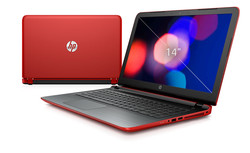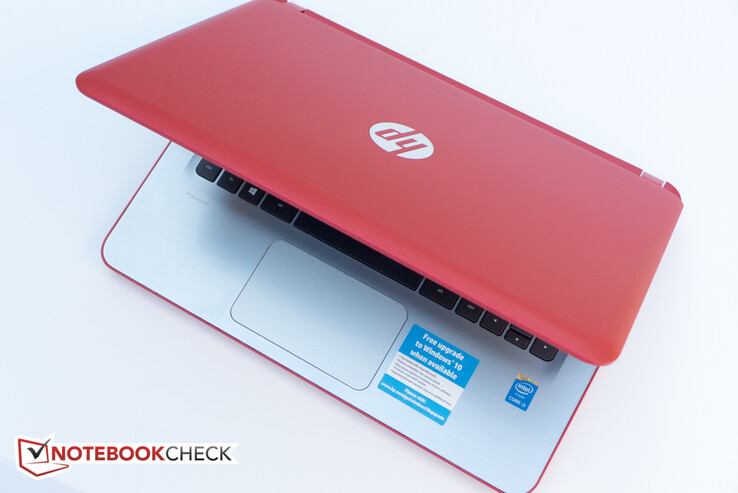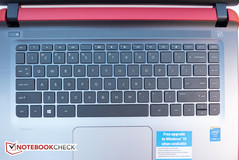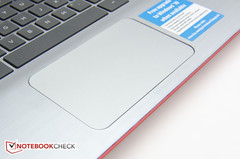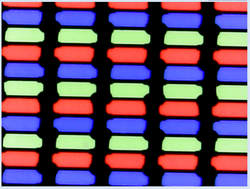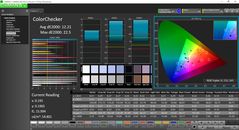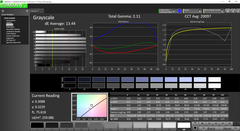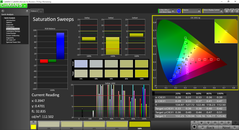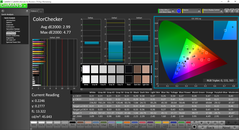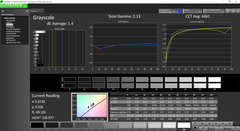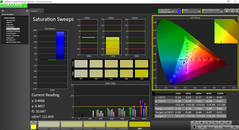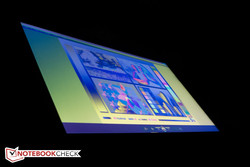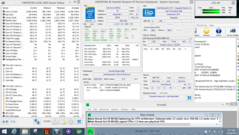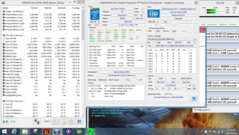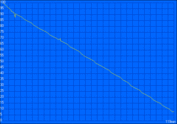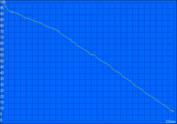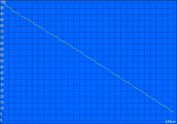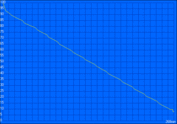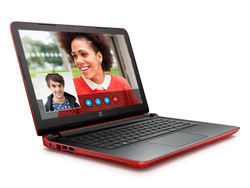HP Pavilion 14t-ab000 (K9E07AV) Notebook Review
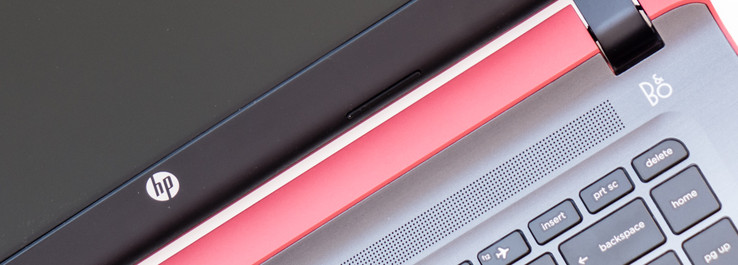
Although 2-in-1 convertibles with 360-degree hinges are all the rage right now, there's of course still a market for inexpensive tried-and-true conventional notebooks in the 14 to 15.6-inch range. HP's Pavilion 14t is such a design. Contrary to the current and widely adapted nomenclature, the "t" in the model name does not indicate a touchscreen, although HP also offers a version with touchscreen - aptly called "Pavilion 14t Touch" - for $80 more. Many low-cost notebooks these days use Celeron and Pentium processors, so it's refreshing to see entry-level notebooks with Core i CPUs. The least expensive current 14t-model starts at $419 with a sixth-generation Skylake Core i3-6100U dual-core processor, 6 GB RAM and Windows 10. The Pavilion 14t is quite configurable and HP offers different processors, including a dual-core i7-6500U CPU with dedicated Nvidia GeForce 940M for $210 more, RAM options up to 16 GB and hard drives up to 2 TB. With the most expensive components selected, the notebook sells for about $950.
Our review model is the older version of the entry-level offering with Core i3-5010U Broadwell CPU, 6 GB DDR3L RAM and Windows 8.1 (upgradable to Windows 10 for free at the time of writing).
While the competition is fierce in the 15-inch range, there are considerably fewer 14-inch notebooks on the market. Examples are the AMD-equipped Acer Aspire ES1-420 as well as the Acer Aspire E5-473G and Lenovo ThinkPad E450 with Intel CPU and dedicated graphics.
Case
The HP Pavilion 14t features an all-plastic construction with a bottom "tray" into which the keyboard deck is inserted. The advantage here is a fairly high rigidity compared to other budget offerings, but of course it also means that the unit needs to be pried apart for upgrade purposes, as there is no dedicated maintenance hatch or cover on the bottom. The lid, which is adorned by a prominent chrome HP logo, is torsionally fairly rigid as well, although moderate presses on the back result in visible distortions on the display. The entire exterior of the notebook is slightly rough to the touch which not only prevents slippage, but also doesn't show fingerprints at all. We would love it if all notebooks were as carefree as the Pavilion in that regard. Natural silver is the standard color, but HP also offers "Blizzard white", "Cobalt blue" and "Sunset red" for $10 more. Our notebook features the latter color and certainly stands out from its black-and-gray competitors. The keyboard tray sports a textured silver aluminum look, but is completely smooth plastic. While it looks good, this is one area where the budget origins of the 14t are very apparent, as even light pressure results in flexing and very noticeable creaking sounds particularly to the left of the touchpad above the optical drive. The hinges are stiff enough to hold the display securely in all positions, although the maximum opening angle of about 135 degrees isn't exactly generous. Overall, we don't have many quibbles with the build quality, as there are no sharp edges or uneven gaps anywhere.
The chassis doesn't break new grounds as far as size or weight are concerned: with dimensions of 13.6 x 9.55 x 0.98 inches and a weight of about 4.25 lbs, the notebook is within a few percentage points of the competition both size and weight-wise. An example: the significantly more expensive Lenovo ThinkPad E450 with dedicated GPU is lighter by only about 5 %, but doesn't feature a DVD burner.
Connectivity
The array of physical ports is standard fare, although a DVD burner is increasingly uncommon these days. The two USB ports on the left side behind the optical drive are very close together, which might lead to contention depending on what's plugged in. The USB 3.0 port on the right side is located roughly in the middle of the notebook and a cable or a larger device protruding here might causes issues for right-handed mouse users.
Communication
Wired connectivity is provided by Realtek RTL8101 (10/100MBit) network card, while a Realtek RTL8188E Wireless LAN 802.11n PCI-E NIC (b/g/n) module with Bluetooth 4.0 handles wireless connections. Signal strength was good and we never encountered dropped connections or other issues during the review period.
Accessories
The shipping carton only includes the notebook, the power adapter and a few pamphlets. Dedicated accessories are not available on the manufacturer's website either, although one could argue that none are required.
Maintenance
Since we didn't want to damage the review notebook, we refrained from opening it up, in particular since there's more involved than just removing a panel. Once open, it should be an easy job to upgrade the RAM (2x slots) or swap out the hard drive for a faster SSD.
Warranty
The notebook features a standard 12-month warranty against defects. HP's warranty extensions - called "Care Packs" - are available as well with a 3-year plan costing $150 at the time of purchase.
Input Devices
Keyboard
At about 1.3 mm, the chiclet-type keyboard features only slightly less key travel than a "standard" notebook at 1.5 mm, but it certainly feels like even less. The keys are flat textured plastic with slightly below average feedback. The stop at the end of the key stroke is rather abrupt, but the noticeable keyboard flex lessens the perceived harshness. We didn't find the flex to be a major issue during our typing sessions, however, since the keyboard doesn't just give in the the center, but even at the perimeter. HP also offers a backlit version of this keyboard for $30 more, which might be an advisable option for users who want to work in semi-dark to dark environments.
Touchpad
The rather large clickpad allows the fingers to glide easily and offers simple touch-gesture support (for example, scrolling with two fingers) as well. Right clicks are only recognized at the bottom third on the right side; left clicks on the other hand trigger at the upper edge of the pad on both the left and right side. Tapping on the surface without actually clicking induces a noticeable rattling sound.
Display
One of the main downfalls of the HP 14t is without question its display. Budget notebooks generally come with TN displays and the Pavilion is of course no exception. The resolution of 1366 x 768 pixels seems OK for an entry-level configuration, but Full-HD resolution (1920 x 1080 pixels) is increasingly common and much more appropriate for a notebook with a 14-inch screen.
The maximum brightness of 220 nits is not enough to overcome the reflections of the glare-type screen in brightly-lit environments or outside; battery use dims the display even further.
| |||||||||||||||||||||||||
Brightness Distribution: 86 %
Center on Battery: 193.2 cd/m²
Contrast: 232:1 (Black: 1.029 cd/m²)
ΔE ColorChecker Calman: 12.21 | ∀{0.5-29.43 Ø4.78}
ΔE Greyscale Calman: 13.44 | ∀{0.09-98 Ø5}
56.26% sRGB (Argyll 1.6.3 3D)
38.62% AdobeRGB 1998 (Argyll 1.6.3 3D)
38.62% AdobeRGB 1998 (Argyll 3D)
56.3% sRGB (Argyll 3D)
37.38% Display P3 (Argyll 3D)
Gamma: 2.11
CCT: 20097 K
| HP Pavilion 14t-ab000 K9E07AV | Acer Aspire ES1-420-377F | Acer Aspire E5-473G-59QT | Lenovo ThinkPad E450 20DDS01E00 | Dell Latitude E7450 | |
|---|---|---|---|---|---|
| Display | 13% | 1% | 8% | 72% | |
| Display P3 Coverage (%) | 37.38 | 42.31 13% | 37.82 1% | 40.37 8% | 66.6 78% |
| sRGB Coverage (%) | 56.3 | 63.6 13% | 56.9 1% | 60.8 8% | 92.4 64% |
| AdobeRGB 1998 Coverage (%) | 38.62 | 43.71 13% | 39.07 1% | 41.71 8% | 67.7 75% |
| Screen | 34% | 19% | 14% | 73% | |
| Brightness middle (cd/m²) | 238.4 | 233 -2% | 238 0% | 218 -9% | 280 17% |
| Brightness (cd/m²) | 218 | 225 3% | 228 5% | 211 -3% | 257 18% |
| Brightness Distribution (%) | 86 | 87 1% | 90 5% | 76 -12% | 75 -13% |
| Black Level * (cd/m²) | 1.029 | 0.4 61% | 0.54 48% | 0.53 48% | 0.3 71% |
| Contrast (:1) | 232 | 583 151% | 441 90% | 411 77% | 933 302% |
| Colorchecker dE 2000 * | 12.21 | 10.53 14% | 10.64 13% | 11.16 9% | 3.45 72% |
| Greyscale dE 2000 * | 13.44 | 11.91 11% | 11.74 13% | 12.58 6% | 3.35 75% |
| Gamma | 2.11 104% | 2.42 91% | 2.34 94% | 2.37 93% | |
| CCT | 20097 32% | 13043 50% | 14940 44% | 6940 94% | |
| Color Space (Percent of AdobeRGB 1998) (%) | 38.62 | 36 -7% | 39 1% | 60 55% | |
| Color Space (Percent of sRGB) (%) | 56.26 | 57 1% | 61 8% | 92 64% | |
| Total Average (Program / Settings) | 24% /
28% | 10% /
14% | 11% /
12% | 73% /
73% |
* ... smaller is better
Analyses with a spectrophotometer show very inaccurate colors across all saturation levels. In fact, the color accuracy is about the worst we've encountered in a while with certain colors reaching a DeltaE-deviation of 22.5. The DeltaE average of over 13 for grayscale is far from great as well and the display is incredibly cool at almost 20100K. The result is a overwhelming bluish tint. It doesn't help that the display responds exceptionally well to calibration - after all, most users shopping for a notebook in this price range won't own calibration equipment costing more than the notebook itself. The contrast ratio of 232:1 is also very poor and blacks are not nearly saturated enough.
The color space coverage is also far from outstanding at 56 % for sRGB and 39 % for AdobeRGB. The display is certainly not suited for professional scenarios even if calibrated properly.
The combination of low brightness - about 195 nits in the center with the notebook running on battery - and a highly reflective screen makes working in brightly-lit environments a chore and frequent screen adjustments are necessary to find the perfect "workable" angle. Working outdoors in the shade or on an overcast day might still be possible, but direct sunlight is absolutely out of the question. Still, the HP 14t's performance is on par with other budget laptops for the most part. The matte display of the Lenovo ThinkPad E450 doesn't get any brighter, but is more suitable for outdoor use since reflections are minimized.
As typical for TN displays, the viewing angle stability is rather poor. The side-to-side stability is not too bad, so sharing the screen is still possible. Deviations in the vertical plane on the other hand - particularly when the screen is viewed from below - alter the picture dramatically. An IPS panel would of course eliminate nearly all the flaws this particular TN display exhibits, but the price of entry would be much higher as a result.
Performance
Currently, the HP Pavilion 14t is offered with processors ranging from the dual-core Core i3-6100U up to the dual-core i7-6500U with a discrete Nvidia GeForce 940M graphics card (+$210). The base configuration includes 6 GB of DDR3L RAM (4 GB + 2 GB) running in dual-channel mode; the maximum possible configuration is 16 GB (+$180). Upgrading from the standard 1 TB 5400 RPM hard drive to a either a 1 TB hybrid drive with SSD cache or standard 2 TB drive costs $40 and $100, respectively. Our review notebook uses a previous-generation Core i3 processor, 6 GB of RAM and a 1 TB conventional hard drive.
Processor
The Intel Core i3-5010U is a Broadwell ULV CPU with a core clock speed of 2.1 GHz. Hyper-Threading is enabled, but a Turbo is lacking. Our low-end configuration makes use of the integrated HD 5500 graphics, but the higher-end Skylake versions (starting with the i5-6200U) are available with dedicated graphics cards. Both the single as well as multi-threaded performance is where we would expect it to be and by no means sluggish: the Core i5-5200U, a more mainstream processor with Turbo, is only about 10 - 15 % faster. We don't have any data for the new Core i3-6100U yet, but we don't expect significant gains compared to the older i3-5010U.
System Performance
With a score of 2755 points in PCMark 7, the HP Pavilion 14t does actually quite well, although it of course trails systems equipped with a Solid State Drive like the Lenovo Thinkpad E450, which managed 4797 points (+75 %). As we've mentioned in other articles, the PCMark 7 benchmark scores improve significantly with faster storage, so this result is not at all unexpected. The AMD-equipped Acer Aspire ES1-420 offers extremely pedestrian performance and is roughly 100 % slower than our review candidate. Because of the platter-based drive, perceived performance is very sluggish with applications taking much longer to load than we would like and a cold boot to the desktop requiring one minute and 10 seconds. While we certainly understand HP's attempts to keep the costs down, we think that a SSD drive should be at least an option for performance-oriented users. In our opinion, it isn't worth spending $950 for a high-end Core i7 version with dedicated GPU only to pair it up with a conventional hard drive - even one with SSD cache.
| HP Pavilion 14t-ab000 K9E07AV HD Graphics 5500, 5010U, HGST Travelstar 5K1000 HTS541075A9E680 | Acer Aspire ES1-420-377F Radeon HD 8240, E1-2500, Western Digital Scorpio Blue WD5000LPVT | Acer Aspire E5-473G-59QT GeForce 940M, 5200U, Seagate ST500LM000 Solid State Hybrid Drive | Lenovo ThinkPad E450 20DDS01E00 Radeon R7 M260, 5200U, Samsung CM871 MZ7LF192HCGS | |
|---|---|---|---|---|
| PCMark 7 | -30% | 1% | 143% | |
| Score (Points) | 2755 | 1313 -52% | 2780 1% | 4797 74% |
| System Storage (Points) | 1627 | 1505 -7% | 5062 211% | |
| PCMark 8 | 15% | 18% | ||
| Home Score Accelerated v2 (Points) | 2823 | 3167 12% | 3299 17% | |
| Creative Score Accelerated v2 (Points) | 3119 | |||
| Work Score Accelerated v2 (Points) | 3514 | 4151 18% | 4186 19% | |
| Storage Score (Points) | 2102 | |||
| Total Average (Program / Settings) | -30% /
-30% | 8% /
10% | 81% /
80% |
| PCMark 7 Score | 2755 points | |
| PCMark 8 Home Score Accelerated v2 | 2823 points | |
| PCMark 8 Creative Score Accelerated v2 | 3119 points | |
| PCMark 8 Work Score Accelerated v2 | 3514 points | |
Help | ||
Storage Device
HD Tune attests the 750 GB drive (HGST Travelstar 5K1000) an average transfer rate of 79 MB/s, which is actually on the slower side for 5400 RPM drives. Particularly unimpressive are the 4K read and writes speeds of 0.28 and 0.7 MB/s CrystalDiskMark reported, which in turn are one reason for the rather sluggish application performance.
Gaming Performance
The integrated HD Graphics 5500 operates at a speed between 300 and 900 MHz. Occasional gaming is possible, but most current titles will only run smoothly at their respective lowest settings. We checked the performance using the now ancient Anno 2070 from 2011: at the high preset (AA, 2xAF), but still at the native resolution of 1366 x 768 pixels, the notebook only managed about 20 fps, which already is barely good enough for stutter-free game play. Although it stands to reason that the Intel HD Graphics 520 integrated in the new generation of Intel CPUs will offer better performance, users interested in more frequent gaming sessions should opt for the i5-6200U with the Nvidia GeForce 940M for $170 more. The Acer Aspire E5-473G with Core i5-5200U CPU also comes with the Nvidia GeForce 940m and is a much better choice.
| low | med. | high | ultra | |
|---|---|---|---|---|
| Anno 2070 (2011) | 65.7 | 33.2 | 19.8 |
| 3DMark 11 Performance | 1270 points | |
| 3DMark Ice Storm Standard Score | 50026 points | |
| 3DMark Cloud Gate Standard Score | 4833 points | |
| 3DMark Fire Strike Score | 705 points | |
Help | ||
Stress Test
During the CPU-portion of the test with Prime95 active, both cores started out at a stable 2100 MHz with the temperature at 34 degrees C. After about 10 minutes, the CPU reached 60 degrees, which coincides wit the next step up in fan speed. At this point, nothing changed and both the CPU frequency as well as the temperature remained stable. To stress the GPU we use Furmark. The temperature immediately rose to 65 degrees and the GPU dropped to 800 MHz with brief jumps to 850 MHz. After about 15 min, the temperature increased to 66 degrees, which once again brought with it an increase in the fan speed. The temperature then dropped back down to 63 degrees with no further changes in the clock speed. Running both Prime95 and Furmark in parallel resulted in a rise of the temperature to 64 degrees, which then was followed by a reduction of the CPU speed to between 1100 - 1200 MHz and a GPU speed of 800 - 850 MHz. The temperature stabilized at about 60 degrees and neither the CPU nor the GPU speed changed at all even after several hours. A quick check with 3DMark11 showed no performance difference between the cold state and immediately after the stress test. Even running the notebook on battery power seemed to not affect the performance at all and the point difference was insignificant.
Emissions
System Noise
Although the fan is running most of the time, the Pavilion 14t is remarkably quiet with the fan only emitting a faint whooshing sound. A fairly large chassis allows for an efficient cooling system, after all. It's also obvious that HP developed it for much more potent hardware - we need to keep in mind that the 14t is available with Core i7 CPU and a dedicated graphics card. During idle, the noise level remains under 32 dB, so it's actually the hard drive that's more noticeable when it is being accessed. Under load, the system topped out at about 35 dB - both the Aspire ES1-420 as well as the Lenovo ThinkPad E450 reached above 40 dB at similar utilization levels. For that reason, the 14t is especially suited for noise sensitive environments.
Noise level
| Idle |
| 31.6 / 31.4 / 31.8 dB(A) |
| HDD |
| 33 dB(A) |
| DVD |
| 37.7 / 38.6 dB(A) |
| Load |
| 33.3 / 34.6 dB(A) |
 | ||
30 dB silent 40 dB(A) audible 50 dB(A) loud |
||
min: | ||
Temperature
Even though the fan doesn't seem to work very hard most of the time, the temperatures are exceptionally well-controlled. Idle temps don't exceed 28 degrees - in this case just 5 degrees above ambient - and even under load we didn't encounter temperatures above 33 degrees C. The Acer Aspire E5-473G doesn't behave nearly as well in comparison with temps approaching 47 degrees in some areas.
(+) The maximum temperature on the upper side is 33.4 °C / 92 F, compared to the average of 36.9 °C / 98 F, ranging from 21.1 to 71 °C for the class Multimedia.
(+) The bottom heats up to a maximum of 32.6 °C / 91 F, compared to the average of 39.2 °C / 103 F
(+) In idle usage, the average temperature for the upper side is 26.4 °C / 80 F, compared to the device average of 31.3 °C / 88 F.
(+) The palmrests and touchpad are cooler than skin temperature with a maximum of 29.8 °C / 85.6 F and are therefore cool to the touch.
(±) The average temperature of the palmrest area of similar devices was 28.7 °C / 83.7 F (-1.1 °C / -1.9 F).
Speakers
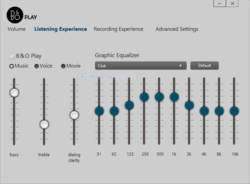
HP proudly displays a Bang & Olufsen log on the right side of the speaker bar, which occupies the area just above the keyboard tray. While the sound is certainly better than what we are used to from budget notebooks, it's by no means eye (or ear)-opening. The B&O Play software allows the user to choose from a myriad of different settings, ranging from classical to rock and country, just to name a few. Some of the settings are very aggressive, so it's best to adjust the graphic equalizer by hand. Even so, we found the sound either to shrill or too muffled most of the time.
Battery Life
With a battery capacity of only 41 Wh / 2700 mAh, we didn't have high expectations as far as the battery life is concerned. Rightfully so, as a more thorough examination shows: during our WLAN test with the display set to 150 nits and the balanced profile (in this case "HP Recommended") enabled, the notebook only lasted for about 4 hours. The Thinkpad E450 shut down after about 6 hours and 50 minutes, even though its battery is only about 15 % larger. DVD playback was possible for 4.5 hours and during the Battery Eaters Classic test, which checks the shortest runtime, the notebook managed about 2 hours. Overall the performance here isn't very impressive. One advantage is that the battery isn't integrated, so the user has the option to purchase a spare.
Pros
Cons
Verdict
For the price, the HP Pavilion 14t does a few things right: the chassis is fairly sturdy, nice to look at and offers decent build quality as well as ergonomics. The CPU performance is a notch above other manufacturer's entry-level configurations with AMD, Celeron, or Pentium CPUs and the 14t remains exceptionally cool and quiet even when under load. The display is not very bright though particularly with the notebook running on battery and the resolution of 1366 x 768 seems a little dated, given that it's the standard for 11.6-inch displays. The color accuracy is worse than anything we've seen in a while - even when compared to other budget displays. We also are less than impressed by the performance of the platter-based hard drive. A hybrid HDD (offered as an option) should be standard and we would love to see SSDs offered as well. Boot times of 70 seconds or more aren't really acceptable in this day and age. Lastly, the battery life is far from impressive at four hours - not long enough to get the user or student through an entire workday.
In its entry-level configuration the HP 14t offers quite a decent price-to-performance ratio. The 14-inch notebook could do with a better display though and optional SSDs - particularly for the higher-end configurations.
HP Pavilion 14t-ab000 K9E07AV
- 11/01/2015 v4 (old)
Bernhard Pechlaner




